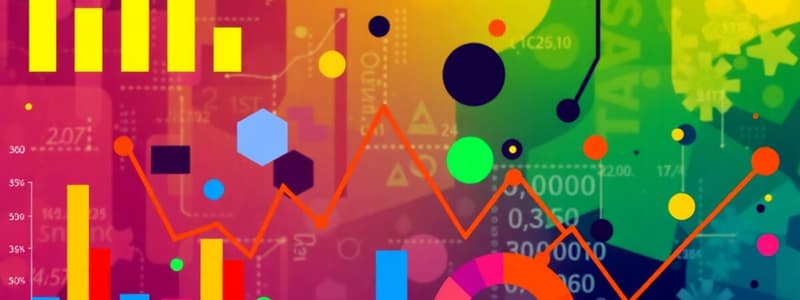Podcast
Questions and Answers
What is the primary focus of descriptive statistics?
What is the primary focus of descriptive statistics?
- Summarizing and describing a dataset (correct)
- Collecting data through surveys
- Testing hypotheses using sample data
- Making predictions about a population
Which of the following best defines a sample in statistics?
Which of the following best defines a sample in statistics?
- A subset of a population used to draw conclusions (correct)
- A technique used to summarize data features
- A method of collecting qualitative data
- The totality of individuals in a study
What type of data is represented by numerical values?
What type of data is represented by numerical values?
- Qualitative data
- Quantitative data (correct)
- Categorical data
- Ordinal data
Which method is crucial for ensuring reliability in data collection?
Which method is crucial for ensuring reliability in data collection?
What is the significance of statistical analysis in decision-making?
What is the significance of statistical analysis in decision-making?
Which type of data can take on any value within a specified range?
Which type of data can take on any value within a specified range?
What is a primary use of inferential statistics?
What is a primary use of inferential statistics?
What is the measure called that is often used to summarize the central tendency of a dataset?
What is the measure called that is often used to summarize the central tendency of a dataset?
Flashcards
Statistics
Statistics
A branch of mathematics that focuses on collecting, organizing, analyzing, interpreting, and presenting data.
Descriptive Statistics
Descriptive Statistics
Deals with summarizing and describing the main features of a dataset by using measures like mean, median, mode, and standard deviation. It also uses charts and graphs to visualize data.
Inferential Statistics
Inferential Statistics
Uses data collected from a sample to draw conclusions and make inferences about a larger population.
Population
Population
Signup and view all the flashcards
Sample
Sample
Signup and view all the flashcards
Qualitative Data (Categorical Data)
Qualitative Data (Categorical Data)
Signup and view all the flashcards
Discrete Data
Discrete Data
Signup and view all the flashcards
Continuous Data
Continuous Data
Signup and view all the flashcards
Study Notes
Topic: Statistics
- Statistics is a branch of mathematics dealing with the collection, analysis, interpretation, presentation, and organization of data.
Key Concepts
-
Descriptive statistics: Summarizes and describes the main features of a dataset. This includes measures like mean, median, mode, standard deviation, and creating charts and graphs to visualize data.
-
Inferential statistics: Uses data from a sample to draw conclusions about a larger population. It involves making predictions, estimations, and tests of hypotheses about a population based on the sample. This often uses probability and sampling techniques.
-
Population: The entire group of individuals or items that are of interest.
-
Sample: A subset of the population used to make inferences about the entire population. A good sample tries to represent the population as closely as possible.
Types of Data
-
Qualitative data (categorical data): Represents categories or groups. Examples include eye color, gender, or types of cars.
-
Quantitative data (numerical data): Represents numerical values. Can be further divided into:
- Discrete data: Values are countable whole numbers (e.g., number of children).
- Continuous data: Values can take on any value within a range (e.g., height, weight).
Statistical Methods
-
Data collection: Collecting data through various methods, such as surveys, experiments, and observations. Ensuring data collection is accurate and reliable is critical.
-
Data organization and presentation: Arranging and presenting data in a clear and understandable way. Useful tools include tables, charts (histograms, bar graphs, pie charts), and graphs.
-
Data analysis: Performing calculations and manipulations on the data to uncover patterns and relationships. This includes measures of central tendency (mean, median, mode), measures of variability (range, standard deviation), and correlation.
Significance of Statistics
-
Making informed decisions: Statistical analysis is vital in making informed decisions in various fields, including business, healthcare, and social sciences.
-
Understanding patterns and trends: Through statistical analysis, one can identify patterns and trends in data that may not be obvious otherwise.
-
Testing hypotheses: Statistics provides methods to test hypotheses about a population using sample data.
-
Predicting future outcomes: Statistical models can be used to predict future outcomes based on past data.
-
Quantifying uncertainty: Any statistical inference includes considerations of the uncertainty in the results or conclusions. This often involves confidence intervals and p-values.
Applications
-
Business: Analyzing market trends, customer behavior, and financial performance.
-
Healthcare: Studying disease prevalence, treatment effectiveness, and patient outcomes.
-
Social sciences: Analyzing social trends, attitudes, and behaviors.
-
Engineering: Evaluating product performance, quality control, and reliability.
-
Science: Testing hypotheses, analyzing experimental data, and drawing conclusions about natural phenomena.
Studying That Suits You
Use AI to generate personalized quizzes and flashcards to suit your learning preferences.




